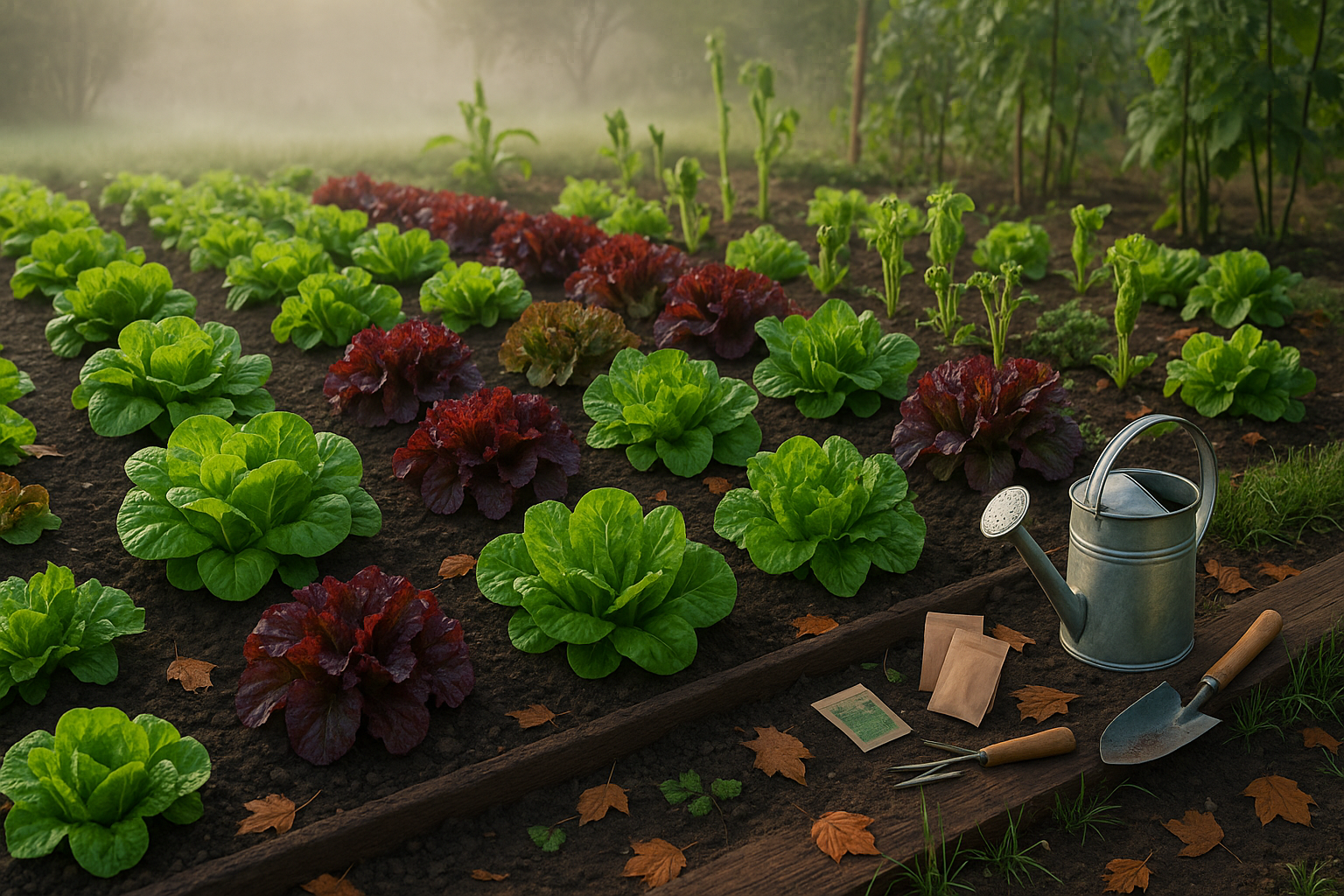Why Plant Lettuce in the Fall?
Planting lettuce in the fall offers gardeners many benefits over spring sowing, especially in flavor and reliability. Cooler autumn temperatures are ideal for lettuce growth because they help prevent bolting—a process where the plant shoots up a seed stalk and turns bitter, which often happens in spring as days warm quickly.
The crisp, cool air of fall encourages lettuce leaves to develop a sweeter, more tender taste, making it a delightful reward after the heat of summer.
Choosing Lettuce Varieties for Autumn
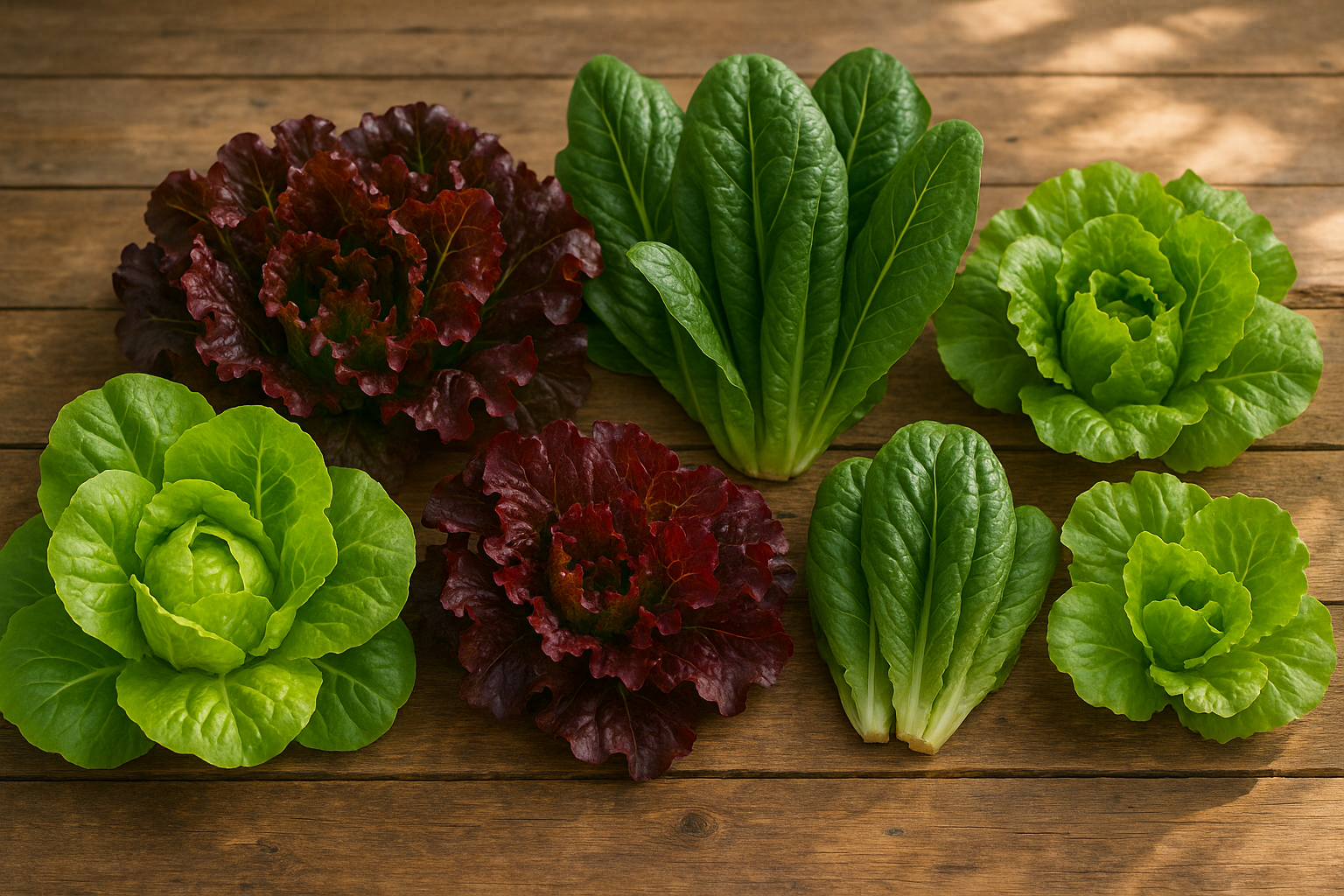
When selecting lettuce varieties for autumn planting, look for types known for cold tolerance, such as:
- Romaine
- Butterhead (like ‘Buttercrunch’)
- Leaf lettuces (such as ‘Red Sails’ or ‘Salad Bowl’)
- Some Batavia/crisphead types
These varieties handle shorter, cooler days well and are less prone to stress-related bolting.
Common Misconceptions and Tips
A common misconception is that lettuce is too delicate to withstand chilly weather, but many types easily handle light frosts and may even become more flavorful because of it. Gardeners in regions with mild winters can overwinter hardy varieties under a simple row cover or cold frame, extending the harvest into the next season.
For best results, sow seeds in late summer for a steady fall harvest, and keep newly seeded beds moist since autumn rains alone may not be enough. With the right planning, fall lettuce is not only possible but incredibly rewarding and less work than battling spring’s sudden temperature spikes.
Choosing the Best Lettuce Varieties for a Late Harvest
When planning your late-season lettuce harvest, it’s smart to compare the main types: romaine, butterhead, leaf, and crisphead. Romaine offers a crisp texture and resilience to chilly falls, especially varieties like ‘Parris Island Cos’ that can handle light frost. Butterhead lettuces, such as ‘Buttercrunch,’ are prized for their tender leaves and relative cold tolerance—perfect for cooler months.
Leaf lettuces like ‘Red Sails’ or ‘Salad Bowl’ mature quickly (sometimes in as little as 30 days), so you can sow them in succession for a steady supply. Crispheads, like iceberg varieties, typically demand longer growing periods (75+ days) and are less forgiving of cold snaps, making them a bit trickier for fall gardens; however, look for specialized cold-tolerant types if you love that classic crunch.
Pay attention to seed packets for each variety’s “days to maturity”—this tells you when to plant for a timely crop before deep frost. For the most reliable late harvest, use a mix of varieties rather than relying on just one type.
Seed blends or mixed plantings let you spread out harvests, as different types mature at different times, and you’ll discover which lettuces thrive best in your garden’s microclimate. Plus, with a colorful mix, fall salads are not only fresh but visually stunning.
Don’t forget to stagger your planting dates by a week or two for each type—this simple strategy extends your harvest window and guarantees an abundance of crisp leaves deep into autumn.
When and How to Plant Fall Lettuce
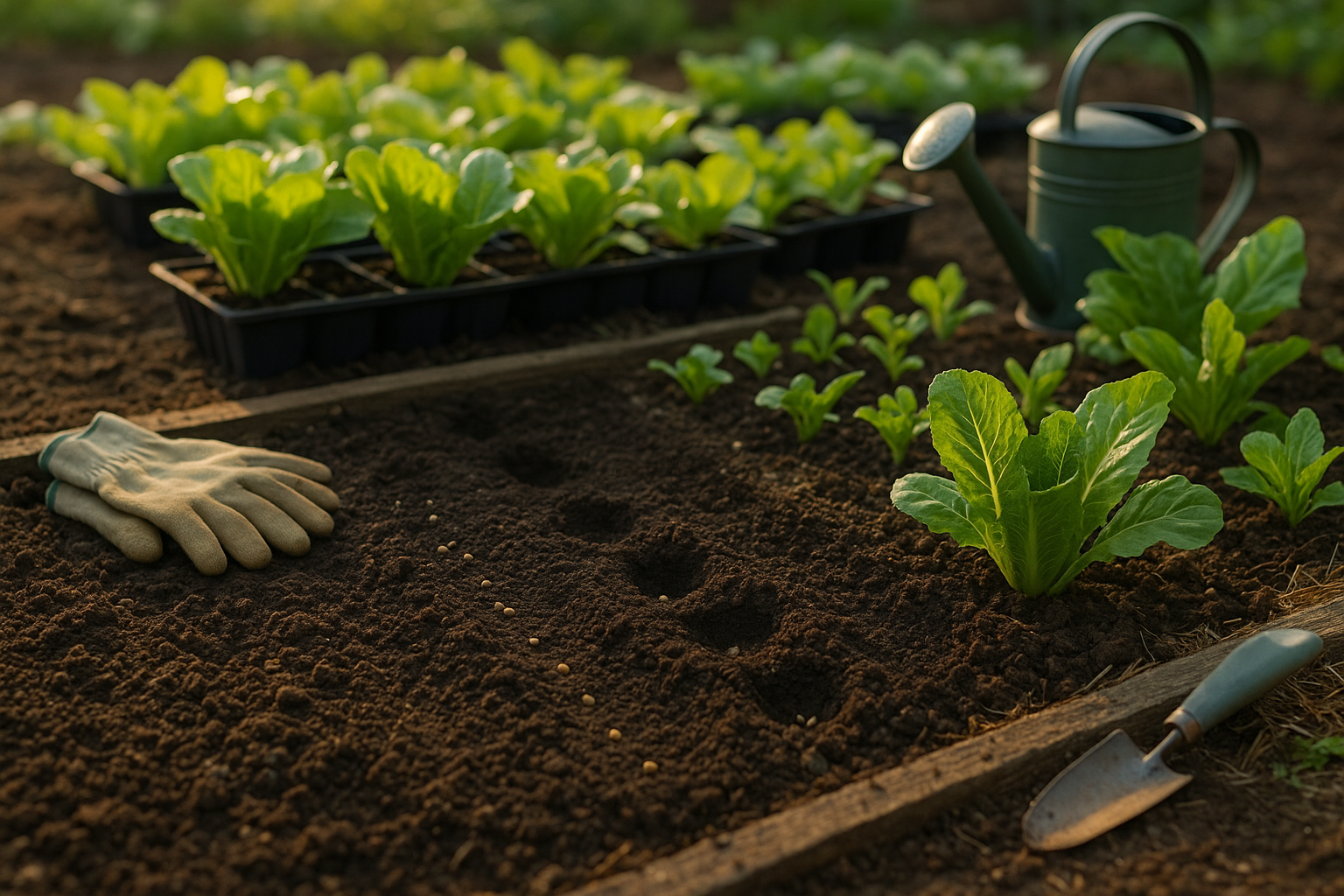
Planting fall lettuce is all about timing and preparation to ensure sweet, tender leaves before winter sets in. To find the best planting window, start by checking your area’s average first fall frost date using local frost charts—these are often available online from sources like your county extension office.
Next, look at your lettuce seed packet for the “days to maturity.” Subtract that number from your first frost date, then add an extra week or two to account for slower fall growth. This calculation gives you your last safe planting date.
For example, if your frost date is October 15th and your lettuce takes 60 days to mature, aim to plant by mid-August.
Direct Seeding Outdoors
- Sow seeds about 1/4 inch deep, spacing each seed 1 inch apart in rows 12 inches apart.
- Thin seedlings to 4-6 inches apart once they have a couple of true leaves—this gives each plant enough space to develop.
Starting Seeds Indoors
- Sow seeds in seed trays about 3-4 weeks before your outdoor planting date.
- Transplant seedlings into the garden once they have at least two true leaves, spacing them 4-6 inches apart.
Succession Sowing for a Continuous Harvest
Try planting a small batch of seeds every 1-2 weeks instead of all at once. This way, fresh lettuce will be ready to harvest as other plants finish, keeping your salad bowl full longer.
Additional Tips
- Water consistently to keep soil moist.
- Use lightweight row covers in early fall to protect young plants from heat or surprise cold snaps.
These small steps can make a big difference in your fall lettuce success!
Soil Preparation and Site Selection
Choosing the right spot and preparing your soil are key steps for a thriving garden. Look for a location that gets at least six to eight hours of direct sunlight daily—vegetables and most flowers need plenty of light to grow vigorously.
Ideal soil should be well-drained and rich in organic matter; if your soil feels heavy or tends to form puddles, mix in compost, aged manure, or leaf mulch to boost nutrients and improve drainage. Aim for a neutral pH around 6.0 to 7.0, which you can check with an inexpensive soil test kit from your local garden center. If the soil is very acidic or alkaline, make adjustments by adding lime or sulfur as recommended.
For areas with poor or compacted soil, raised beds offer a practical solution—fill them with a mix of topsoil, compost, and coarse sand or perlite to encourage healthy root growth and drainage. Container gardening is another flexible option for patios or small spaces; just be sure your pots have drainage holes and use high-quality potting mix.
To protect your garden from early frosts, choose a spot with good air circulation, avoid low-lying “frost pockets,” and consider temporary covers like garden fabric or cold frames in unpredictable spring weather. Healthy, well-prepared soil and a smart site choice give your plants the best chance to thrive all season long.
Essential Care for Fall Lettuce Growth
Watering plays a crucial role in growing healthy fall lettuce, as these leafy greens prefer soil that stays consistently moist but never saturated. Aim to water deeply about two to three times per week, adjusting based on rainfall and temperature. Light, frequent watering leads to shallow roots and stunted growth, so always let the top inch of soil dry before re-watering.
To further support stable moisture and temperature, add a 2-inch layer of organic mulch, such as straw or shredded leaves, around your lettuce plants. Mulching not only conserves moisture and keeps the soil cooler during unexpected warm days, but also suppresses weeds that can compete for nutrients.
As daylight shrinks and temperatures dip, fertilizing becomes even more important. Start with a balanced organic fertilizer or a compost-rich soil mix when planting, and side-dress with a nitrogen-rich fertilizer (like fish emulsion) every two weeks until the first frost. This encourages steady leaf production without promoting overly rapid, weak growth.
Remember to avoid over-fertilizing late in the season, as excess nitrogen can make plants more susceptible to frost damage. By combining consistent watering, smart mulching, and targeted feeding, you’ll set your fall lettuce up for crisp, flavorful harvests right up until winter’s arrival.
Protecting Lettuce from Pests, Diseases, and Chilly Nights
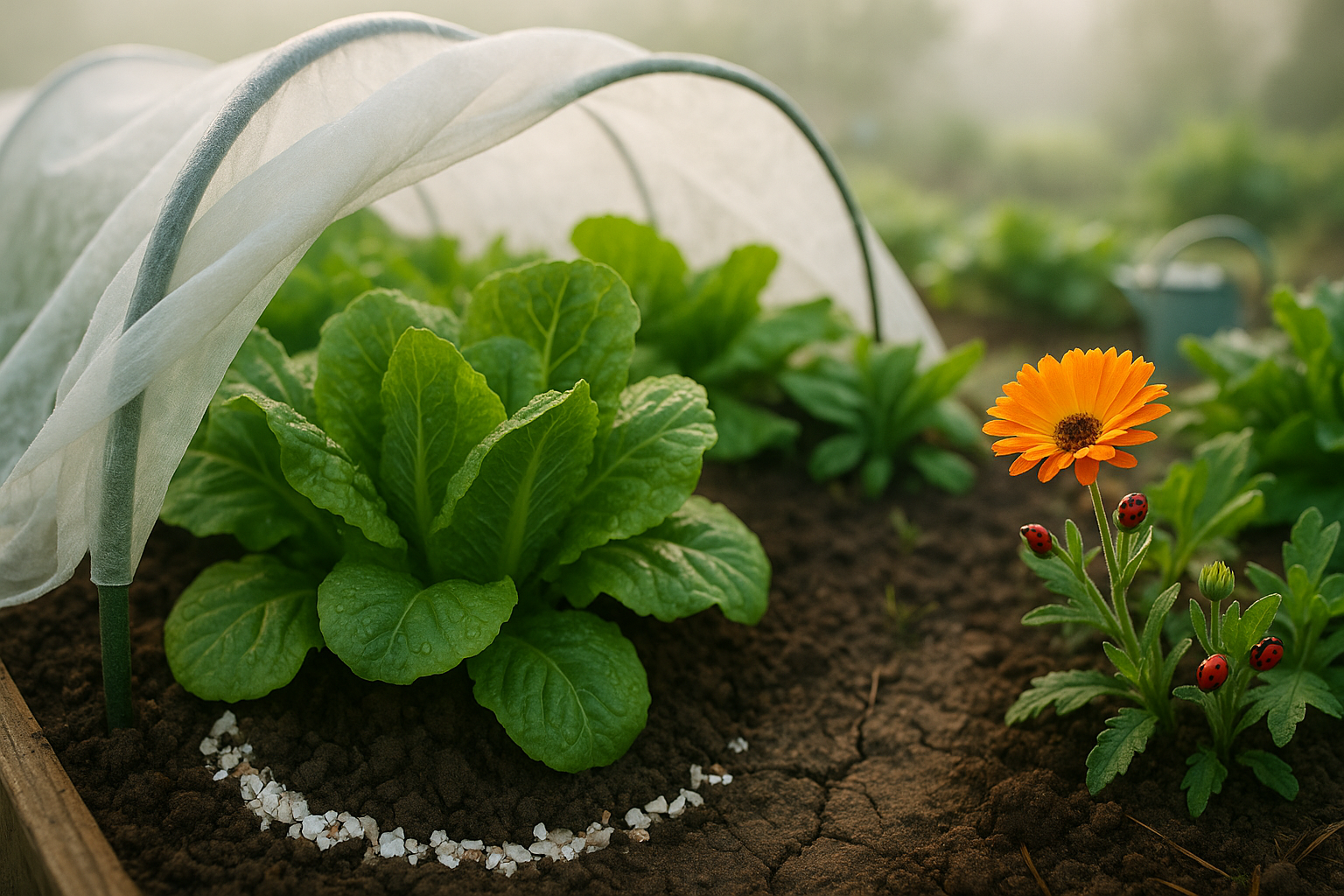
Fall-grown lettuce is vulnerable to various pests, diseases, and sudden temperature drops, but some simple methods can help keep your plants healthy.
Pests
Pests like slugs, snails, and aphids become active in cooler, damper weather. Combat slugs and snails by hand-picking them in the evening, deploying beer traps, or spreading a barrier of crushed eggshells or diatomaceous earth around your lettuce. For aphids, gently wash them off with a spray of water or attract natural predators like ladybugs and hoverflies by planting nearby flowers such as calendula or nasturtiums.
Diseases
Disease often strikes when plants are crowded or wet. Space your lettuce well to encourage good airflow, and water early in the day, aiming at the soil rather than the leaves to prevent moisture from lingering overnight. If you notice yellowing leaves or soft rot, remove affected plants promptly to reduce the spread.
Protecting Against the Cold
As temperatures begin to drop, unexpected frosts may threaten tender leaves. You can shield lettuce with lightweight row covers or floating fabric, which protect against both cold and insect pests without stifling airflow. Cold frames offer sturdier, reusable protection and can extend your harvest well into late fall. For just a few prized lettuce heads, even a simple DIY cloche—like an upturned plastic bottle with the bottom cut off—provides an extra layer of defense during chilly nights.
With these tips, your lettuce can thrive through the challenges of fall and reward you with a crisp, healthy harvest.
Harvesting and Storing Your Lettuce Bounty
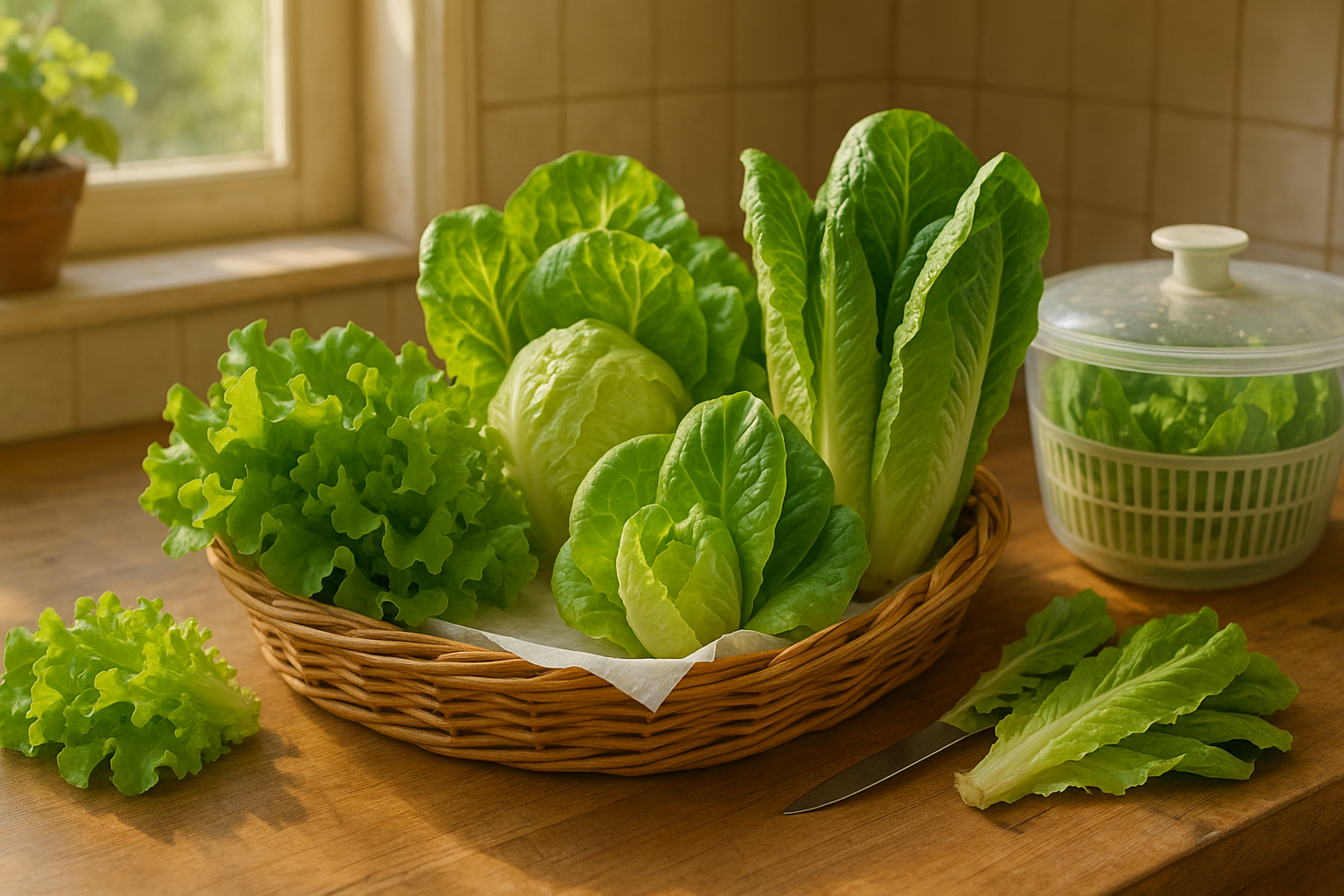
Knowing when and how to harvest your lettuce is essential for enjoying crisp, flavorful leaves all season long. If you prefer a steady supply, try the cut-and-come-again method—ideal for loose-leaf and romaine varieties.
Harvest when the leaves are four to six inches tall by snipping outer leaves about an inch above the base, taking only what you need and leaving the center to regrow for future picks. For full-head types like butterhead or iceberg, wait until the heads feel firm and well-formed, then cut them off at soil level early in the morning when they’re at their freshest and most hydrated.
Handle leaves gently to prevent bruising, and bring them indoors right away. To keep your lettuce crisp, rinse thoroughly in cold water to remove soil or bugs, then use a salad spinner or clean kitchen towel to dry. Moisture left on leaves can cause rapid spoilage, so ensure they’re completely dry before storing.
Line a storage container or a large resealable bag with a paper towel, add the lettuce, and cover with another towel to absorb excess moisture. Store in the crisper drawer of your refrigerator, where lettuce can stay fresh for up to a week. Check regularly and remove any leaves that look wilted or slimy to prevent spoilage from spreading.
With these simple harvesting and storage tips, you’ll enjoy garden-fresh salads long after the initial pick!
